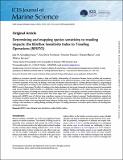Por favor, use este identificador para citar o enlazar a este item:
http://hdl.handle.net/10261/321667COMPARTIR / EXPORTAR:
 SHARE SHARE
 CORE
BASE CORE
BASE
|
|
| Visualizar otros formatos: MARC | Dublin Core | RDF | ORE | MODS | METS | DIDL | DATACITE | |

| Título: | Determining and mapping species sensitivity to trawling impacts: the BEnthos Sensitivity Index to Trawling Operations (BESITO) |
Autor: | González-Irusta, José Manuel; De-la-Torriente, Ana; Punzón, Antonio; Blanco, Marian; Serrano, Alberto; Birchenough, Silvana | Palabras clave: | Medio Marino y Protección Ambiental Centro Oceanográfico de Santander |
Fecha de publicación: | 2018 | Editor: | Oxford University Press | Resumen: | Applying an ecosystem approach requires a deep and holistic understanding of interactions between human activities and ecosystems. Bottom trawling is the most widespread physical human disturbance in the seabed and produces a wide range of direct and indirect impacts on benthic ecosystems. In this work, we develop a new index, the BEnthos Sensitivity Index to Trawling Operations (BESITO), using biological traits to classify species according to their sensitivity to bottom trawling. Seventy-nine different benthic taxa were classified according to their BESITO scores in three groups. The effect of trawling on the relative abundance of each group (measured as biomass proportion) was analysed using General Additive Models (GAMs) in a distribution model framework. The distribution of the relative biomass of each group was mapped and the impact of trawling was computed. Species with the lowest BESITO score (group I) showed a positive response to trawling disturbance (opportunistic response) whereas species with values higher than 2 (group III) showed a negative response (sensitive response). Species with a BESITO score of 2 did not show a significant response to the pressure (tolerant response). Trawling disturbance reduced relative biomass of sensitive species by 31% across the study area. This value increased to 46% when shelf-break was considered in isolation and reached values of 59.6% in the most impacted habitat (deep-sea muddy sands). The new index classified successfully the analysed species according to their sensitivity to trawling allowing modeling the impact of trawling disturbance on sensitive species, without the masking effect of opposed responses. | URI: | http://hdl.handle.net/10261/321667 | DOI: | 10.1093/icesjms/fsy030 | ISSN: | 1054-3139 |
| Aparece en las colecciones: | (IEO) Artículos |
Ficheros en este ítem:
| Fichero | Descripción | Tamaño | Formato | |
|---|---|---|---|---|
| fsy030.pdf | 766,24 kB | Adobe PDF |  Visualizar/Abrir |
CORE Recommender
SCOPUSTM
Citations
24
checked on 06-may-2024
WEB OF SCIENCETM
Citations
23
checked on 22-feb-2024
Page view(s)
27
checked on 09-may-2024
Download(s)
13
checked on 09-may-2024
Google ScholarTM
Check
Altmetric
Altmetric
NOTA: Los ítems de Digital.CSIC están protegidos por copyright, con todos los derechos reservados, a menos que se indique lo contrario.
